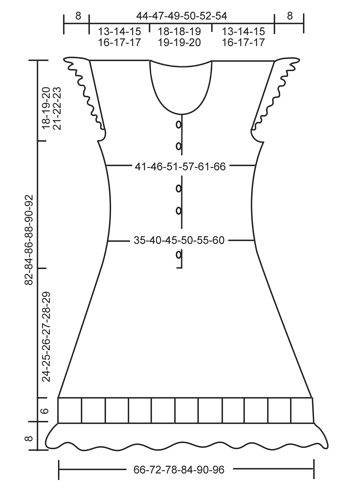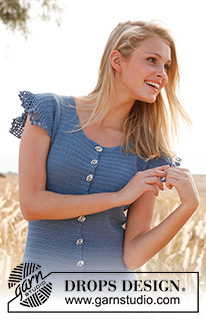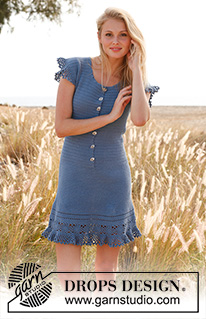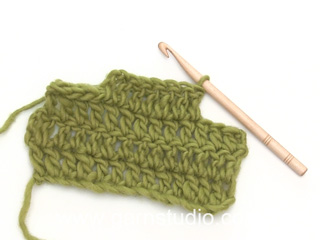Campanula |
|||||||||||||
 |
 |
||||||||||||
Crochet DROPS dress with buttons at the front and flounce in ”Safran”. Size S-XXXL
DROPS 145-9 |
|||||||||||||
|
CROCHET INFO: Replace first tr on every round/row with 3 ch and finish every round with 1 sl st in 3rd ch from beg of round. CROCHET 2 TR TOG AS FOLLOWS: Work 1 tr in first tr on round below but wait with last pull through, work 1 tr in next tr on round below but on last pull through, pull thread through all 3 loops on hook. 1 tr has been dec. DECREASE TIP (applies to neck): Dec at beg of row as follows: Work sl sts over no of tr to be dec. Dec at end of row as follows: When no of tr to be dec remains, turn. -------------------------------------------------------- DRESS: First work the squares – they are gradually worked tog. Then work along one side of squares and up the skirt and then the top. Finally work flounce along the other side of squares and down, and ruffles around armholes. SQUARE 1: Also see diagram A.1. Crochet 4 ch on hook size 3 mm with Safran and form a ring with 1 sl st in first ch. ROUND 1: 3 ch (= 1 tr), work 11 tr in ch-ring, finish with 1 sl st in 3rd ch from beg of round. ROUND 2: Work 2 ch, 1 dc in next tr, 1 ch * 1 dc in next tr, 1 ch *, repeat from *-* the entire round and finish with 1 sl st in first ch from beg of round. ROUND 3: 1 ch, 1 dc in 2nd ch from previous round, * 4 ch, 1 dc in next ch from previous round *, repeat from *-*, finish with 1 sl st in first dc from beg of round = 12 ch-loops. ROUND 4: 2 ch, 1 dc in first ch-loop, * 4 ch, 1 dc in next ch-loop, 4 ch, 1 dc in next ch-loop, 8 ch (= corner), 1 dc in next ch-loop *, repeat from *-* the entire round, but finish with 1 sl st in first dc from beg of round (instead of 1 dc in next ch-loop). Cut the thread. SQUARE 2: Work as SQUARE 1 from 1st to 3rd round. ROUND 4: Also see diagram A.1. Work as follows: 2 ch, 1 dc in first ch-loop, 4 ch, 1 dc in next ch-loop, 4 ch, 1 dc in next ch-loop, 4 ch, place the square WS against WS with SQUARE 1, work 1 dc in one of the large ch-loops on SQUARE 1 (= corner), 4 ch, 1 dc in next ch-loop on SQUARE 2, * 2 ch, 1 dc in next small ch-loop on SQUARE 1, 2 ch, 1 dc in next ch-loop on SQUARE 2 *, repeat from *-* 1 more time, 4 ch, 1 dc in next large ch-loop on SQUARE 1 (= corner), 4 ch, 1 dc in next ch-loop on SQUARE 2. Then work around SQUARE 2 as follows: ** 4 ch, 1 dc in next ch-loop, 4 ch, 1 dc in next ch-loop, 8 ch, 1 dc in next ch-loop **, repeat from **-** 1 more time but finish with 1 sl st in first dc from beg of round. Cut the thread. Then work SQUARE 2 until a total of 22-24-26-28-30-32 squares have been worked. The last square is worked tog with both the next to last and the first square so that the squares form a circle. SKIRT: READ CROCHET INFO! Work with Safran on hook size 3 mm along one long side of the squares as follows: ROUND 1: 4 tr in each of the large ch-loops in the corners on the squares and 3 tr in each of the small ch-loops = 14 tr per square and 308-336-364-392-420-448 tr in total. Insert a marker at beg of round = mid back. ROUND 2: Work * 1 tr in each of the first 5 tr, then work 2 tr tog - see explanation above - *, repeat from *-* the entire round = 264-288-312-336-360-384 tr. ROUND 3: Work 1 tr in every tr. REMEMBER THE CROCHET TENSION! ROUND 4: 4 ch, skip first tr, * 1 tr in next tr, 1 ch, skip 1 tr *, repeat from *-* the entire round, finish with 1 sl st in 3rd ch from beg of round. ROUND 5: Work 1 tr in every tr and 1 tr in every ch = 264-288-312-336-360-384 tr. ROUND 6: Work 1 tr in every tr. ROUND 7: Work as 4th round. ROUND 8: Work as 5th round. ROUND 9: Work 1 tr in every tr. ROUND 10: Work 1 tr in each of the first 4-6-6-1-8-8 tr, then work 2 tr tog, * 1 tr in each of the next 4-5-6-7-8-9 tr, then work 2 tr tog *, repeat from *-* the entire round = 220-247-273-298-324-349 tr. Piece now measures approx. 14 cm incl crochet squares. Continue in the round with 1 tr in every tr. When piece measures 29-30-31-32-33-34 cm, work next round as follows: 1 tr in each of the first 8-3-7-10-0-2 tr, then work 2 tr tog, * 1 tr in each of the next 8-9-10-11-12-13 tr, then work 2 tr tog *, repeat from *-* the entire round = 198-224-250-275-300-325 tr. Work 1 more round with 1 tr in every tr, cut the thread. Now beg working back and forth from mid front to make openings for buttons. Count 99-112-125-138-150-163 tr from mid back and insert 1 marker (= mid front). Count 3 tr to the right of marker (when piece is in front of you), beg to work here with 1 sl st and 3 ch, then work 1 tr in every tr around the entire dress until beg of round, do not finish round with 1 sl st but work 1 tr at the back of each of the first 6 tr worked (to make overlap for bands) = 204-230-256-281-306-331 tr. Turn and continue back and forth with 1 tr in every tr. AT THE SAME TIME when piece measures 34-35-36-37-38-39 cm, dec 22-23-23-23-23-24 tr evenly as follows: Work 1 tr in each of the first 6-4-6-7-9-3 tr, then work 2 tr tog, * work 1 tr in each of the next 7-8-9-10-11-12 tr, then work 2 tr tog *, repeat from *-* until 7-4-6-8-9-4 tr remain, work 1 tr in each of these = 182-207-233-258-283-307 tr. Continue with 1 tr in every tr. When piece measures 39-40-41-42-43-44 cm, dec 16-17-19-20-23-25 tr evenly as follows: Work 1 tr in each of the first 7-6-7-14-8-8 tr, then work 2 tr tog, * work 1 tr in each of the next 9-10-10-10-10-10 tr, then work 2 tr tog *, repeat from *-* until 8-7-8-14-9-9 tr remain, work 1 tr in each of these = 166-190-214-238-260-282 tr. Continue to work 1 tr in every tr until piece measures 46-47-48-49-50-51 cm. On next row, inc 14 sts evenly as follows: Work 1 tr in each of the first 12-8-4-14-8-16 tr, * then work 2 tr in next tr, 1 tr in each of the next 10-12-14-15-17-18 tr *, repeat from *-* the entire row = 180-204-228-252-274-296 tr. Continue to work 1 tr in every tr until piece measures 56-57-58-59-60-61 cm. On next row, inc 14 sts evenly as follows: Work 1 tr in each of the first 12-8-4-14-8-16 tr, * then work 2 tr in next tr, 1 tr in each of the next 11-14-15-16-18-19 tr *, repeat from *-* the entire row = 194-218-242-266-288-310 tr. Continue with 1 tr in every tr until piece measures 64-65-66-67-68-69 cm. Armholes beg now and front and back pieces are finished separately. FIRST FRONT PIECE: SIZE S: Work tr back and forth over the first 47 tr. AT THE SAME TIME on 3rd row inc 1 tr towards the armhole by working 2 tr in next to last tr (= broad shoulder). Repeat inc on every row 6 more times. AT THE SAME TIME when piece measures 70 cm, beg neck dec as follows: Work until 14 tr remain towards mid front, turn piece. Then dec on every row as follows: 3 tr 1 time, 2 tr 2 times and 1 tr 3 times – SEE DECREASE TIP! After all inc for shoulder and dec for neck, there are 30 tr on row. Continue to work until piece measures 18 cm from where armhole beg, i.e. piece measures approx. 82 cm in total, cut the thread. SIZE M: Work tr back and forth over the first 52 tr. AT THE SAME TIME on 3rd row inc 1 tr towards the armhole by working 2 tr in next to last tr (= broad shoulder). Repeat inc every other row 4 more times. AT THE SAME TIME when piece measures 71 cm, beg neck dec as follows: Work until 14 tr remain towards mid front, turn piece. Then dec on every row as follows: 3 tr 1 time, 2 tr 2 times and 1 tr 3 times – SEE DECREASE TIP! After all inc for shoulder and dec for neck, there are 33 tr on row. Continue to work until piece measures 19 cm from where armhole beg, i.e. piece measures approx. 84 cm in total, cut the thread. SIZE L: Work tr back and forth over the first 57 tr. AT THE SAME TIME on 4th row inc 1 tr towards the armhole by working 2 tr in next to last tr (= broad shoulder). Repeat inc on 8th row (= 2 inc in total). AT THE SAME TIME when piece measures 72 cm, beg neck dec as follows: Work until 15 tr remain towards mid front, turn piece. Then dec on every row as follows: 3 tr 1 time, 2 tr 2 times and 1 tr 3 times – SEE DECREASE TIP! After all inc for shoulder and dec for neck, there are 34 tr on row. Continue to work until piece measures 20 cm from where armhole beg, i.e. piece measures approx. 86 cm in total, cut the thread. SIZE XL: Work tr back and forth over the first 62 tr. AT THE SAME TIME on 2nd row dec 1 tr towards the armhole by working the last 2 tr tog = 61 tr. When piece measures 73 cm, beg neck dec as follows: Work until 15 tr remain towards mid front, turn piece. Then dec on every row as follows: 3 tr 1 time, 2 tr 2 times and 1 tr 3 times – SEE DECREASE TIP! After all dec there are 36 tr on row. Continue to work until piece measures 21 cm from where armhole beg, i.e. piece measures approx. 88 cm in total, cut the thread. SIZE XXL: Work tr back and forth over the first 67 tr. AT THE SAME TIME on 2nd row dec 1 tr towards the armhole by working the last 2 tr tog, repeat dec on every row 2 more times = 64 tr. When piece measures 74 cm, beg neck dec as follows: Work until 16 tr remain towards mid front, turn piece. Then dec on every row as follows: 3 tr 1 time, 2 tr 2 times and 1 tr 3 times – SEE DECREASE TIP! After all dec there are 38 tr on row. Continue to work until piece measures 22 cm from where armhole beg, i.e. piece measures approx. 90 cm in total, cut the thread. SIZE XXXL: Work tr back and forth over the first 71 tr. AT THE SAME TIME on 2nd row dec 1 tr towards the armhole by working the last 2 tr tog, repeat dec on every row 5 more times. AT THE SAME TIME when piece measures 76 cm, beg neck dec as follows: Work until 16 tr remain towards mid front, turn piece. Then dec on every row as follows: 3 tr 1 time, 2 tr 2 times and 1 tr 3 times – SEE DECREASE TIP! After all dec there are 39 tr on row. Continue to work until piece measures 23 cm from where armhole beg, i.e. piece measures approx. 92 cm in total, cut the thread. OTHER FRONT PIECE: Work as first front piece but reversed. BACK PIECE: Work tr back and forth over the middle 88-98-108-118-126-136 tr (6-8-10-12-14-16 tr in each side = armhole). Inc (in the 3 smallest sizes) / dec (in the 3 largest sizes) in each side at the armholes as on front piece. After all inc/dec are done there are 102-108-112-116-120-124 tr on row. When armhole measures 16-17-18-19-20-21 cm vertically, work for another 2 cm only over 30-33-34-36-38-39 tr in each side (the middle 42-42-44-44-44-46 tr = neck), cut the thread. The whole piece measures approx. 82-84-86-88-90-92 cm. ASSEMBLY: Sew shoulder seams edge to edge to avoid a chunky seam. Work 2 rows with dc around the neck (work first row from WS) – make sure to avoid a tight edge and a wide neckline. FLOUNCE AT THE BOTTOM: Work along the other side of squares at the bottom of skirt as follows - beg mid back: ROUND 1: 4 tr in each of the large ch-loops in the corners on the squares and 3 tr in each of the small ch-loops = 14 tr per square and 308-336-364-392-420-448 tr in total. ROUND 2: 4 ch, skip 1 tr, * 1 dc in next tr, 3 ch, skip 1 tr *, repeat from *-* the entire round, finish with 1 sl st in first ch from beg of round = 154-168-182-196-210-224 ch-loops. ROUND 3: 2 ch, 1 dc at the top of first ch-loop from previous round, * 4 ch, 1 dc in next ch-loop *, repeat from *-* the entire round, finish with 1 sl st in first dc from beg of round. ROUND 4: 2 ch, 1 dc at the top of first ch-loop from previous round, * 5 ch, 1 dc in next ch-loop *, repeat from *-* the entire round, finish with 1 sl st in first dc from beg of round. ROUND 5: Work as 4th round. ROUND 6: * 6 ch, 1 dc in next ch-loop *, repeat from *-* the entire round, finish with 1 sl st in first dc from beg of round. ROUND 7: Work as 6th round. ROUND 8: * 7 ch, 1 dc in next ch-loop *, repeat from *-* the entire round, finish with 1 sl st in first dc from beg of round. ROUND 9: Crochet as follows in every ch-loop: 3 dc, 1 picot (= 3 ch, 1 dc in first ch) and 3 dc. Finish with 1 sl st in first dc from beg of round, cut and fasten the thread. RUFFLE AT THE ARMHOLES: Beg at the end of 4th row, counted from where armhole beg. ROW 1: Work 1 dc in outermost st, * then work 3 ch, skip approx. 1 cm, 1 dc in next st *, repeat from *-* until 4th row on the other side, turn piece. ROW 2: 2 ch, 1 dc at the top of first ch-loop, * 4 ch, 1 dc in next ch-loop *, repeat from *-* the entire row, turn piece. ROW 3: 2 ch, 1 dc at the top of first ch-loop, * 5 ch, 1 dc in next ch-loop *, repeat from *-* the entire row (do not work in the 2 ch from beg of row), turn piece. ROW 4: 3 ch, 1 dc at the top of first ch-loop on previous row, * 6 ch, 1 dc in next ch-loop *, repeat from *-* the entire row (do not work the 2 ch from beg of row), turn piece. ROW 5: 3 ch, 1 dc at the top of first ch-loop on previous row, * 6 ch, 1 dc in next ch-loop *, repeat from *-* the entire row (do not work the 3 ch from beg of row), turn piece. ROW 6: 4 ch, 1 dc at the top of first ch-loop on previous row, * 7 ch, 1 dc in next ch-loop *, repeat from *-* the entire row (do not work the 3 ch from beg of row), turn piece. ROW 7: Work as follows in every ch-loop: 3 dc, 1 picot (= 3 ch, 1 dc in first ch) and 3 dc. Cut and fasten the thread. Work the same way at the bottom of the other sleeve. Sew buttons on left band – top button should be 1 cm from the top, then evenly spaced downwards, button through sts. |
|||||||||||||
Diagram explanations |
|||||||||||||
|
|||||||||||||

|
|||||||||||||

|
|||||||||||||
|
Have you made this or any other of our designs? Tag your pictures in social media with #dropsdesign so we can see them! Do you need help with this pattern?You'll find tutorial videos, a Comments/Questions area and more by visiting the pattern on garnstudio.com. © 1982-2024 DROPS Design A/S. We reserve all rights. This document, including all its sub-sections, has copyrights. Read more about what you can do with our patterns at the bottom of each pattern on our site. |
|||||||||||||














































Comments / Questions (43)
Sehr chic
16.12.2012 - 08:01Sehr schönes Kleid. Würde ich gern nachstricken.
14.12.2012 - 11:34Très jolie robe facile à porter, les boutons sur le devant donnent un bel effet.
13.12.2012 - 15:13Pen og yndig, blå sommerkjole til sommerfesten!
13.12.2012 - 12:57Pen og feminin blå kjole, passer godt når du vil pynte deg!
13.12.2012 - 12:13Only Seksteen som navn
12.12.2012 - 10:00Förgätmigej som namn
12.12.2012 - 00:19Ein wunderbares Sommerkleid für jeden Tag!
11.12.2012 - 22:59Midnatssol
11.12.2012 - 16:00Heel schattig!
11.12.2012 - 14:34